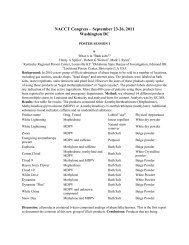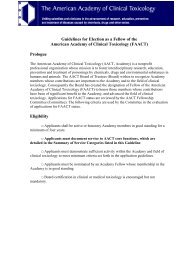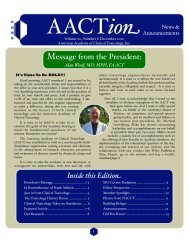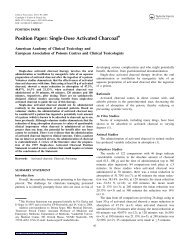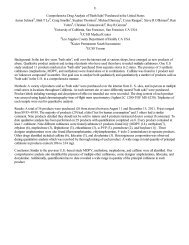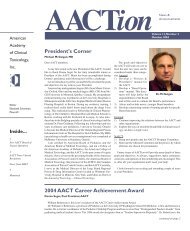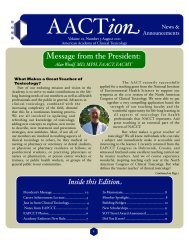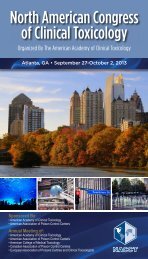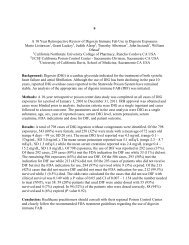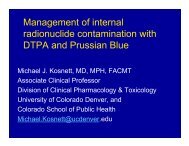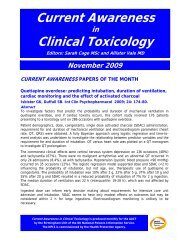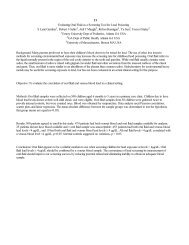Posters IV - The American Academy of Clinical Toxicology
Posters IV - The American Academy of Clinical Toxicology
Posters IV - The American Academy of Clinical Toxicology
You also want an ePaper? Increase the reach of your titles
YUMPU automatically turns print PDFs into web optimized ePapers that Google loves.
available, management by a PC <strong>of</strong> human exposures occurring in their own residence, managed on site<br />
(not HCF) avoided annual medical care costs <strong>of</strong> nearly $9 million; in the Medicaid subgroup, annual<br />
medical care costs avoided were $4 million.<br />
269<br />
Health Policy and Poison Control Centers: Providing Analysis Utilizing a Logic Model<br />
Teresa Dodd-Butera 1 , Molly Broderick 2<br />
1 CSU San Bernardino, San Bernardino CA 2 California Poison Control System, San Diego CA USA<br />
Background: Despite evidence that poison control centers (PCCs) provide cost-effective public health<br />
measures and access, threats for decreased public funding necessitates improved evaluation methods. A<br />
logic model provides an illustration <strong>of</strong> an underlying conceptual framework and the logical connection<br />
within and between systems. Methods: A logic model was utilized to analyze the policy <strong>of</strong> decreasing<br />
public spending for PCCs. An underlying assumption was that PCCs provide essential public health<br />
services. Inputs included stakeholders and resources impacted by the policy to decrease public spending.<br />
<strong>The</strong> logic model also considered negative outcomes for both outpatient and inpatient services which are<br />
impacted if decreased funding levels lead to the elimination <strong>of</strong> access to PCC services. Results:<br />
Immediate impact <strong>of</strong> decreased public spending would deny access to certain essential public health<br />
services, particularly significant to vulnerable populations. Short and long-term outcomes would include<br />
decreased utilization <strong>of</strong> appropriate resources; and increased costs and imposition on emergency services<br />
and resources, respectively. In addition, there is a potential for increased morbidity and mortality due to an<br />
absence <strong>of</strong> preventive services to the public and impediments to training <strong>of</strong> clinical toxicologists.<br />
Conclusions: Logic models for analysis <strong>of</strong> public health policy for PCCs can be effective in establishing<br />
causal models and connectedness <strong>of</strong> systems. In addition, it provides a conceptual and visual frame <strong>of</strong><br />
reference for pr<strong>of</strong>essionals, politicians, and the public which increases transparency for fiscal decisions;<br />
and eliminates the appearance <strong>of</strong> budget reduction in the case <strong>of</strong> decreased public spending for PCC<br />
services, which would actually increase spending for other health services.<br />
270<br />
Follow-up calls: revision <strong>of</strong> the criteria and the procedure<br />
Anne Letarte 1 , Veronique Gross 1 , Monique Dorval 1 , Rene Blais 1<br />
1 Centre antipoison du Quebec (CAPQ), Quebec QC Canada<br />
Background: At the CAPQ, the aim <strong>of</strong> the follow-up (FU) calls is to optimize the care <strong>of</strong> the intoxicated<br />
patient by evaluating both the patient's response to the recommended treatment and the need for further<br />
recommendations. <strong>The</strong> FU calls also serve to determine patient outcome in relation to the acute toxic<br />
episode. With increasing workloads both at the CAPQ and in the critical care units, our specialists in<br />
poison information (SPIs) were questioning the relevance <strong>of</strong> maintaining some FUs. <strong>The</strong> SPIs were also<br />
asking for an update <strong>of</strong> the FU criteria. <strong>The</strong>y wanted more objective criteria that would help them in<br />
making clinical decisions as to whether or not to initiate or discontinue FU. As an organization, we aimed<br />
to improve our patient outcome data. Method: <strong>The</strong> CAPQ created a workgroup that surveyed all <strong>of</strong> the<br />
SPIs and the toxicologists for their specific suggestions to improve our FU criteria. <strong>The</strong> workgroup also<br />
reviewed the <strong>American</strong> Association <strong>of</strong> Poison Control Centers' certification criteria concerning the<br />
outcome data, and examined the FU procedures from four Canadian, two <strong>American</strong> and one European<br />
poison control centres. Based on these data, the workgroup drafted a brand-new FU procedure which was<br />
tested by the SPIs during the months <strong>of</strong> December 2010 and January 2011. Results: Following the test



